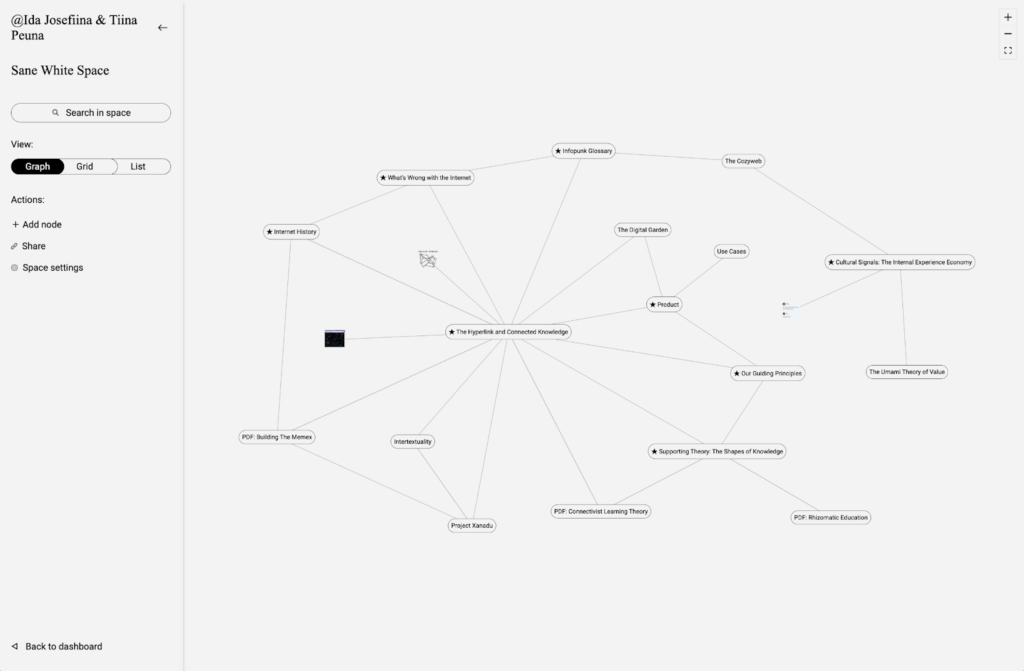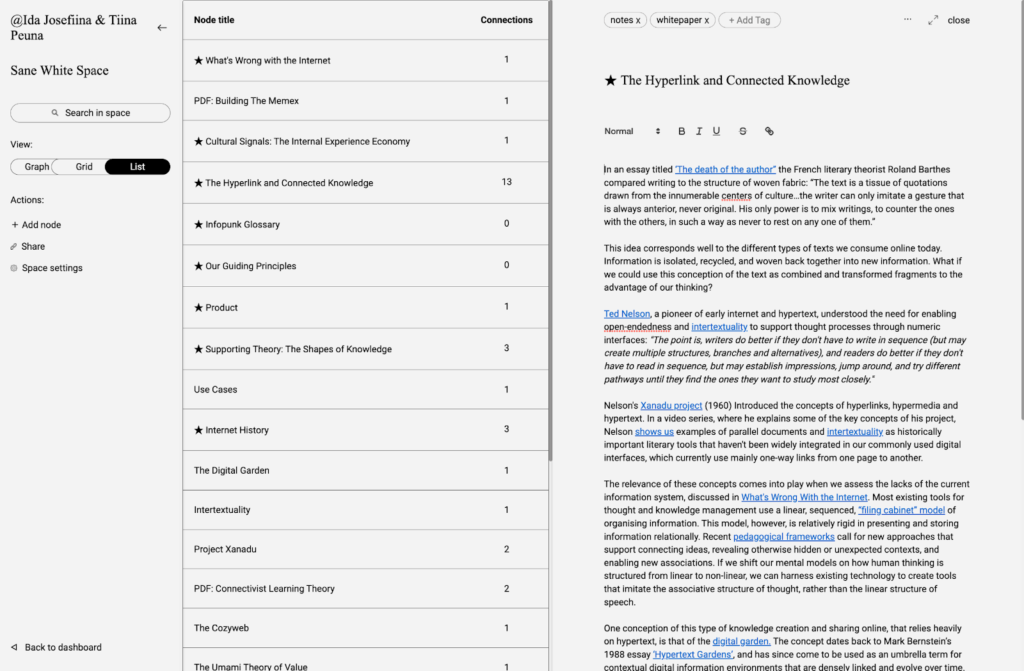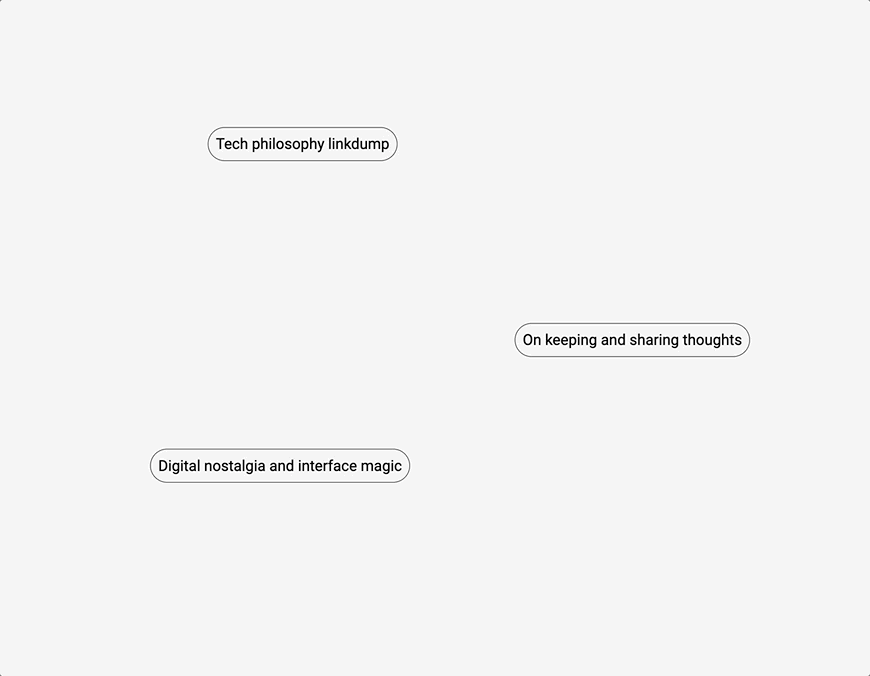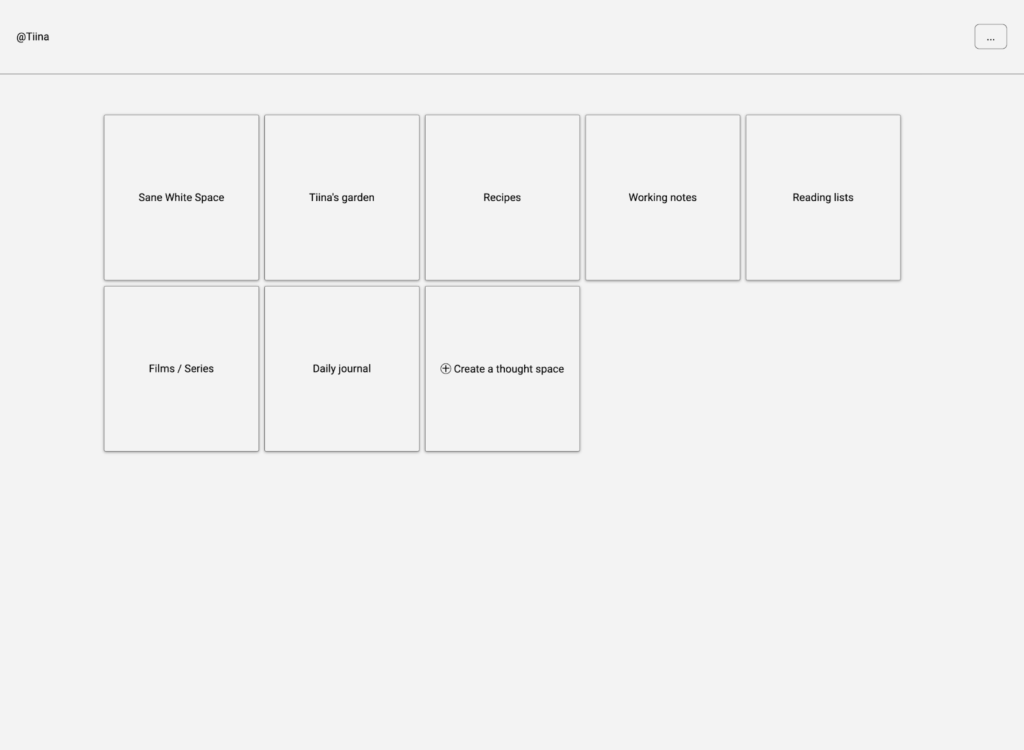Welcome to this edition of our Tools for Thought series, where we interview founders on a mission to help us think better. Ida Josefiina is the co-founder of Sane, a digital gardening tool designed to collect, connect, and share ideas via “thought spaces” — a home for all the thoughts you want to keep, work on, and share with others; a that inspires deep thinking and asking questions.
In this interview, we talked about how to turn data into wisdom, how to make sense of information, how to inspire deep thinking and big questions, how to embrace chaos and complexity, how to facilitate collective creation of knowledge, and much more. Enjoy the read!
Hi Ida, thank you so much for agreeing to this interview. Let’s start with a bit of a philosophical question: what do you think is the difference between information and knowledge?
Super happy to be speaking with you, Anne-Laure!
I think people have always wrestled with the question of how to turn data into information, information into knowledge, and knowledge into wisdom. More information (or more structured information) doesn’t automatically mean more knowledge — or wisdom for that matter.
Knowledge is created when a meta-layer of connections between units of information is added on top. And I would argue that wisdom comes from our ability to truly internalize and utilize that knowledge for good.
The World Wide Web was supposed to be all about creating those meta-layers of connection, and yet it doesn’t seem to work as expected. Why is that?
The creation and sharing of knowledge was at the core of the initial vision for the World Wide Web. But as the internet became widely popular, big tech adopted a business model relying on ads. This catalyzed a massive race for our attention; resulting in anxiety, lack of depth, and general content collapse. There’s information everywhere, but it’s increasingly difficult to make sense of it all.
How does Sane aim to address those challenges?
Sane was born out of conviction that the internet should be a place of curiosity and collaboration, not one of ads and outrage. A place where we choose what to devote our attention to. A place that inspires deep thinking and asking questions. An extension of our minds that’s responsive, not reactive.
Our vision is to build a company that works with intention, diligence, and care to solve one of the most pertinent challenges facing society. We see technology as a means to an end — a tool in our belt where building a better internet means building a better world.
This is an important but ambitious mission! Specifically, how does Sane work?
It is an important mission! And Sane certainly isn’t the only one working on this. Already back in 1945, Vannevar Bush outlined a project called Memex with similar ambitions. Other examples include Ted Nelson’s Project Xanadu, or more recently, Venkatesh Rao’s writings on the Cozy Web. These all have functioned as important reference points for us.
Sane is built on the principles of the connectivist learning theory – meaning we embrace chaos, network, and complexity, and believe that learning comes from combining thoughts, theories, and general information in a useful manner.
Generally, we describe Sane as a tool for collecting, connecting, and sharing ideas. The interface in the product, which we call a ‘thought space’, is in its essence a minimalist digital environment, combined with a set of features that enable anyone to create and connect documents/texts/images related to a given project. It functions as a bank of information sources that are interlinked by the user to form a network of connected nodes. Users can create as many thought spaces as they desire, choosing whether to make them private, collaborative (coming soon), or public. They can be published and shared as unique URLs to showcase any type of knowledge.
You can use Sane for storing your working notes, sharing projects and research, or planting seeds for future ideas.
How do you recommend someone get started with Sane?
You can get started with Sane by signing up at sane.fyi and creating your first thought space! Everything works through right-click commands, including the creation of new nodes. An idea for your first thought space could be to build a digital garden that functions as an introduction to yourself, such as this one created by my co-founder Tiina.
One of the key ideas behind Sane is to not just build another note-taking tool, but to facilitate the sharing of thought processes and ideas. This is why we really encourage users to publish thought spaces, and use Sane as a blog or website!
What kind of people use Sane?
We’ve playfully called Sane the infopunk’s digital garden. An infopunk is a person embracing alternative information dynamics. Someone who challenges the foundational ideas around questions such as “where do ideas come from?”, “who determines what knowledge is?”,“‘who has access to knowledge and through what channels?”, and so forth.
Less conceptually speaking, Sane is used by all kinds of people in various fields. Founders, researchers, content creators, novelists, teachers, students, and people who are generally interested in sharing their idea dumps, thought processes, and musings with more depth and nuance.
What about you… How do you personally use Sane?
I told my co-founder the other day that if all else fails, I’m happy we’ve built a product that at least its creators use obsessively.
I’ve started using Sane for many purposes. I have two accounts, one for myself personally, and one for Sane. On my personal dashboard, I’ve created thought spaces, for example, for showcasing my personal profile (basically in replacement of a personal website), for mapping out intellectual rabbit holes I’d like to dive deeper into, and for collecting random bits of research on transhumanism.
On Sane’s account, we’ve created thought spaces such as a guide for building thought spaces, an update on the business and our goals to share with our partners, and one that showcases all the reading recommendations from our guests on Reverb (our podcast).
And finally… What’s next for Sane?
The next phases of Sane’s development will focus on removing obstacles for thought. In practice this means building platform integrations and a mobile version for the editor to make Sane accessible on all devices. We’re also working on support for audio and other media types to remove as many constraints as possible.
Our vision for Sane is facilitating collective creation of knowledge, and enabling as many people as possible to discover and access this knowledge. For our product development this means building with collaboration and publishing in mind in the long term. We’re hoping this will open up entirely new ways for people to interact with information online.
Thank you so much for your time! Where can people learn more about Sane and give it a try?
Thank you! This was fun. I hope your readers give Sane a go! Folks can sign up and see examples of how people have been using Sane at sane.fyi.
Also, I host a podcast called Reverb by Sane where we dig into the ideas and research around some of the most important questions of our time. Guests have included people like Dr. Isabel Millar, Sari Azout, Maggie Appleton, Dr. Anders Sandberg, and Professor Sune Lehmann, among others. You can have a listen through Spotify, Apple Podcasts, or through other channels.
For updates, follow us on Twitter, Instagram, and sign up to our newsletter (where we send new Reverb episodes including guests’ reading recommendations, product updates, and the occasional philosophical musings on the state of the internet and the world).




